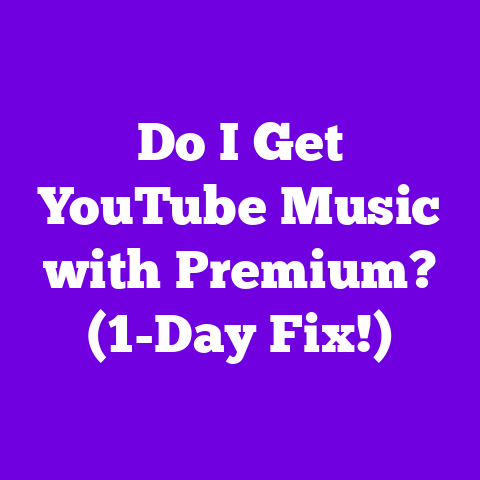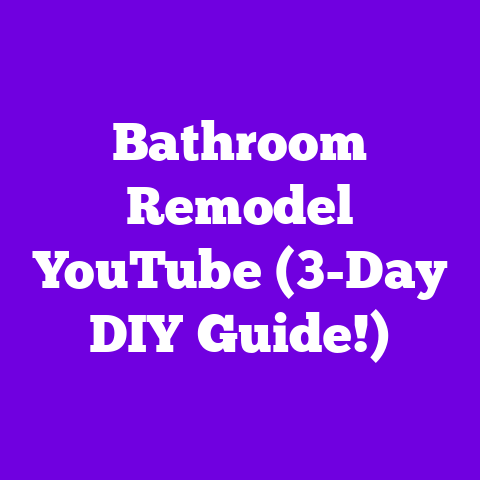Disable Ads on YouTube Videos? (Quick Grade!)
Ever been completely engrossed in a YouTube video, hanging on every word, only to be ripped back to reality by a blaring ad for something you absolutely don’t need?
I know the feeling.
It’s like being jolted awake from a really good dream.
This frustration is something almost every YouTube user experiences, and it begs the question: Will we ever truly be able to escape the ads?
The burning question for us creators and viewers alike is this: Is it even possible to disable ads on YouTube videos as we move into 2025? That’s what we’re diving into today.
We’ll be exploring the current state of YouTube ads, what they mean for both creators and viewers, and potential ways to manage them.
So, buckle up, because this is going to be an interesting ride!
Section 1: The Evolution of YouTube Ads
Let’s take a quick trip down memory lane.
Remember the early days of YouTube?
Back then, ads were a rarity.
But as the platform grew, so did the need for monetization.
It was a necessary evil, right?
From its humble beginnings, YouTube advertising has morphed into a complex ecosystem.
We saw the introduction of skippable ads, those glorious five seconds where you could feel like you were sticking it to the man.
Then came the non-skippable ads, the bane of our existence.
And let’s not forget the rise of YouTube Premium, promising an ad-free utopia… for a price.
Today, YouTube is plastered with various types of ads.
We’ve got display ads lurking on the side, overlay ads that hover on the video itself, skippable and non-skippable pre-roll and mid-roll ads, and those quick bumper ads that barely give you time to blink.
According to Statista, in 2023, YouTube’s advertising revenue reached a staggering $31.5 billion.
That’s a lot of eyeballs being sold!
But what does all this advertising do to us, the viewers?
Well, it’s safe to say it affects our experience.
Imagine settling in for a relaxing evening of cat videos, only to be bombarded with ads for car insurance and the latest fast-food burger.
It’s disruptive, right?
Studies have shown that constant ad interruptions can lead to ad fatigue, making viewers less receptive to the message and more likely to just tune out completely.
Section 2: The Financial Implications for Content Creators
Now, let’s flip the coin and look at things from the creator’s perspective.
Ads are the lifeblood of many YouTube channels.
They’re what allows us to keep creating the content you love.
But how does it all work?
YouTube operates on a revenue-sharing model.
Creators earn a portion of the ad revenue generated from their videos.
The exact percentage can vary, but it’s generally around 55% for creators and 45% for YouTube.
This money is crucial for sustaining content creation, paying for equipment, hiring editors, and, you know, actually making a living.
I’ve spoken with many fellow creators who have different views on ads.
Some rely heavily on ad revenue to keep their channels afloat.
They see ads as a necessary evil, a way to provide free content while still earning a living.
Others dislike the presence of ads, feeling they detract from the viewing experience.
They might explore alternative monetization strategies to reduce their reliance on ads.
And speaking of alternatives, the rise of ad blockers has definitely thrown a wrench into the works.
While viewers might rejoice at the lack of ads, it directly impacts creators’ earnings.
This has led many creators to explore other ways to generate revenue, such as merchandise sales, sponsorships, crowdfunding platforms like Patreon, and even direct donations.
It’s a constant balancing act between providing a good viewing experience and keeping the lights on.
Section 3: Current Methods to Disable Ads
Okay, let’s get down to brass tacks.
How can you actually disable ads on YouTube videos right now?
There are a few options, each with its own pros and cons.
First and foremost, there’s YouTube Premium.
This subscription service is the official way to get rid of ads.
For a monthly fee, you get ad-free viewing across all devices, plus access to YouTube Music Premium and the ability to download videos for offline viewing.
It’s convenient, supports creators, and provides a seamless experience.
The downside?
It costs money.
Then we have ad blockers.
These software tools and browser extensions block ads from appearing on websites and YouTube videos.
Popular ad blockers include AdBlock, Adblock Plus, and uBlock Origin.
They’re generally free and easy to use, but their effectiveness can vary.
YouTube has been known to crack down on ad blockers, so they might not always work perfectly.
Beyond these mainstream solutions, there are some technical workarounds that some users employ.
These might involve modifying browser settings, using specific devices or apps, or even tinkering with network configurations.
However, these methods are often more complex and might not be suitable for the average user.
Plus, they might violate YouTube’s terms of service.
Section 4: Legal and Ethical Considerations
Before you go full-on ad-blocking ninja, let’s talk about the legal and ethical implications.
It’s not always as simple as “I don’t want to see ads, so I’m going to block them.”
From a legal standpoint, the legality of ad-blocking is a bit of a gray area.
In most jurisdictions, it’s generally considered legal to use ad-blocking software for personal use.
However, there have been some legal challenges, particularly from websites and content providers who rely on ad revenue.
It’s a constantly evolving landscape.
But even if it’s legal, is it ethical?
That’s where things get tricky.
Disabling ads directly impacts content creators’ ability to earn a living.
It’s a bit like walking into a store and taking something without paying for it.
You’re consuming the content, but you’re not contributing to its creation.
Of course, there’s also the perspective of advertisers to consider.
They pay good money to reach potential customers, and ad-blocking undermines their efforts.
Ad revenue is essential for YouTube’s sustainability, allowing the platform to continue operating and providing content.
It’s a complex ecosystem with many stakeholders.
Section 5: The Future of Ads on YouTube
So, what does the future hold for ads on YouTube?
What can we expect by 2025?
It’s time to put on our futurist hats and make some educated guesses.
I think we’ll see a greater emphasis on personalized ads.
AI and machine learning are becoming increasingly sophisticated, allowing YouTube to serve ads that are more relevant to individual viewers.
This could mean fewer irrelevant ads and a more engaging experience.
We might also see the rise of new ad formats.
Imagine interactive ads that allow you to play a mini-game or take a poll.
Or perhaps ads that are seamlessly integrated into the content itself, blurring the line between advertising and entertainment.
What do viewers want?
Well, they generally want fewer ads, more relevant ads, and less disruptive ads.
They want to support creators, but they also want a good viewing experience.
It’s a delicate balance that YouTube needs to strike.
How will content creators adapt?
I think we’ll see more creators diversifying their revenue streams, relying less on traditional ad revenue and more on merchandise sales, sponsorships, and community support.
We might also see the rise of exclusive content for paying members, creating a more direct connection between creators and their fans.
Conclusion
So, can you disable ads on YouTube videos in 2025?
The answer, as you might have guessed, is complicated.
Yes, there will likely still be ways to block ads, whether through YouTube Premium, ad blockers, or technical workarounds.
However, the effectiveness and ethical implications of these methods will continue to be debated.
The future of ads on YouTube is a constantly evolving landscape, shaped by viewer preferences, creator needs, and the platform’s financial ecosystem.
Whether you choose to embrace the ads, subscribe to YouTube Premium, or explore ad-blocking options is ultimately up to you.
I encourage you to think critically about the role of advertising in the digital world and how it impacts the content you consume.
Share your experiences, explore different options, and let your voice be heard.
The future of YouTube is in our hands.





